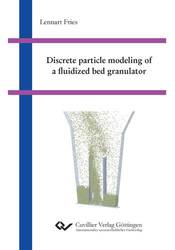| Fachbereiche | |
|---|---|
| Buchreihen (96) |
1378
|
| Nachhaltigkeit |
3
|
| Gesundheitswesen |
1
|
| Geisteswissenschaften |
2363
|
| Naturwissenschaften |
5406
|
| Ingenieurwissenschaften |
1791
|
| Allgemeine Ingenieurwissenschaften | 292 |
| Maschinenbau und Verfahrenstechnik | 861 |
| Elektrotechnik | 686 |
| Bergbau- und Hüttenwesen | 30 |
| Architektur und Bauwesen | 75 |
| Allgemein |
97
|
|
Leitlinien Unfallchirurgie
5. Auflage bestellen |
|
Erweiterte Suche
Discrete particle modeling of a fluidized bed granulator
Lennart Fries (Autor)Vorschau
Leseprobe, PDF (4,8 MB)
Inhaltsverzeichnis, PDF (88 KB)
Size-enlargement and structuration processes in fluidized beds such as granulation and agglomeration play an important role in the pharmaceutical and fine chemical industries as well as in food technology to improve the flowability and the instant properties of solid products. Dustfree and free-flowing particles can be produced in a process with favourable heat- and mass transfer conditions. Furthermore, this technology allows the formulation of particles with novel functionalities by applying coating layers or via the encapsulation of active ingredients. Several interdependent micro mechanisms including particle collisions, wetting, drying and phase transitions govern the process dynamics and complicate predictions on the effect of variable operating conditions on product properties such as structure, strength and re-dissolution behaviour. Profound knowledge on these mechanisms is needed to understand the influence of individual process parameters on the final product properties.
A suitable approach to model the particle interactions in fluidized beds is the Discrete Element Method (DEM) coupled with Computational Fluid Dynamics (CFD). Information on gas and particle velocities, particle rotation and collision dynamics, which are very complicated to measure in fluidized beds, can be studied in detail with this technique.
This thesis presents DEM-CFD simulation results for three different granulator configurations (top-spray, Wurster-coater, spouted bed) in comparison to experimental results, regarding the agglomeration of amorphous maltodextrin (DE 21). In simulation and experiment the identical geometry of the equipment was used. Mechanical material properties, such as the coefficient of restitution and the Young’s modulus, which are required for the DEM model and which are frequently used as fitting parameters, were measured via static and dynamic deformation tests using maltodextrin agglomerates, beads and bars. The strength of the experimentally produced agglomerates was characterized with a compression tester. Their flow behaviour was assessed with the help of a shear cell.
Very promising results were obtained showing that the homogeneity of particle wetting can well be approximated with the residence time distribution of the particles inside the spray zone.Homogeneous wetting allows achieving a narrow product size distribution (Fries et al., 2011a).Furthermore, the growth rate of the agglomerates can well be correlated with the simulated wetting intensity, the collision frequency and the collision velocity distribution inside the spray zone. The agglomerate strength shows a strong correlation with the particle-wall collision frequency and velocity distribution found in the simulations. Good agreement was found between the simulation results for the maximum particle deformation and for the energy dissipation during collisions and the measured deformation at the breakage point and the breakage energy.
Due to the high numerical effort, DEM is only suitable for small scale applications. However, the obtained information on the kinetics of particle-particle interactions can be applied as input for macroscopic process models in the framework of a multi scale modeling scheme (Fries et al., 2011b; Werther et al., 2011).
It can be concluded that DEM is a powerful tool for the detailed characterization of fluidized bed granulators. Highly relevant practical answers can be obtained from the model such as the choice of the optimal equipment geometry depending on material properties and product requirements. The model can point out where to position the spray nozzles in order to achieve homogeneous particle wetting and if a draft tube is helpful to maintain stable particle circulation. Based on such findings the model shows potential to increase the throughput of a fluidized bed granulator, while avoiding a bed collapse.
| ISBN-13 (Printausgabe) | 9783954042456 |
| ISBN-13 (E-Book) | 9783736942455 |
| Buchendformat | B5 |
| Sprache | Englisch |
| Seitenanzahl | 222 |
| Umschlagkaschierung | glänzend |
| Auflage | 1. Aufl. |
| Erscheinungsort | Göttingen |
| Promotionsort | Hamburg-Harburg |
| Erscheinungsdatum | 29.10.2012 |
| Allgemeine Einordnung | Dissertation |
| Fachbereiche |
Ingenieurwissenschaften
Maschinenbau und Verfahrenstechnik |
| Schlagwörter | Technische Mechanik, Strömungsmechanik, Thermodynamik, Allgemeine Verfahrenstechnik |








